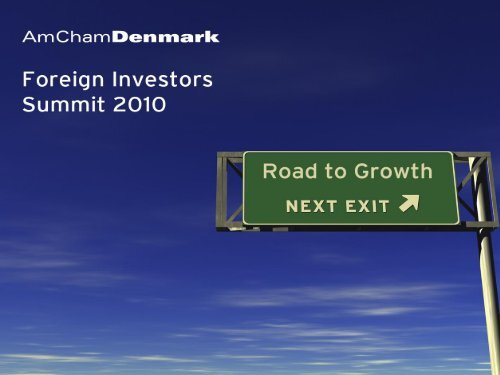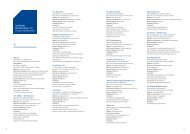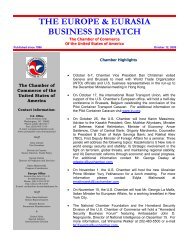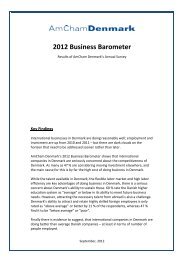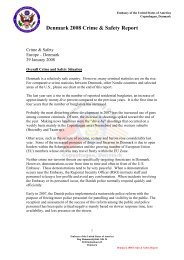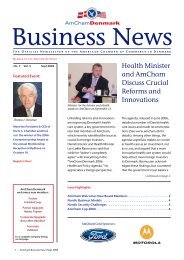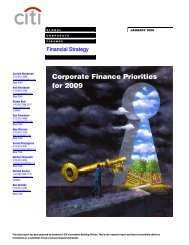Download a copy of the presentation (PDF 5mb)
Download a copy of the presentation (PDF 5mb)
Download a copy of the presentation (PDF 5mb)
You also want an ePaper? Increase the reach of your titles
YUMPU automatically turns print PDFs into web optimized ePapers that Google loves.
09:20 Welcome & Introduction<br />
09:35 Foreign Company Investment<br />
Presentations by: Stephen Brugger,<br />
Leif Bech Fallesen, Erik van Snippenberg and<br />
Minister Troels Lund Poulsen<br />
10:30 Panel Discussion<br />
Panelists: Erik van Snippenberg, Anne Skovbro<br />
Karsten Hønge and Claus Frelle-Petersen<br />
11:00 Break
About <strong>the</strong> 2010 Business Barometer<br />
– Conducted between August 24 and September 13<br />
– Sent to 237 general managers <strong>of</strong> AmCham member<br />
companies encompassing a broad cross-section <strong>of</strong> <strong>the</strong><br />
international and danish business base<br />
– Received 106 responses (45% response rate)<br />
– Respondents represent companies with headquarters both<br />
inside (35%) and outside (65%) Denmark<br />
– Primary focus: company trends (investments/jobs) and talent
Business Barometer Results – Company trends<br />
How have/will your company’s investments in Denmark<br />
change(d) over <strong>the</strong> past year/next year?
Business Barometer Results – Company trends<br />
What was/is <strong>the</strong> trend with respect to <strong>the</strong> number <strong>of</strong> people employed<br />
in your company in Denmark over <strong>the</strong> past year/next year?
Business Barometer Results – Company trends<br />
Is/has your company considered options <strong>of</strong> moving<br />
investments/jobs out <strong>of</strong> Denmark
Business Barometer Results – Company trends<br />
If you answered ”yes” to considering moving investments/jobs out <strong>of</strong><br />
Denmark, which <strong>of</strong> <strong>the</strong> following are/were factors in <strong>the</strong> decision?
Business Barometer Results – Company trends<br />
Will <strong>the</strong> slow growth in labor productivity negatively impact your<br />
company’s future investments in Denmark?
Business Barometer Results – Company trends<br />
How would you rank Denmark’s openness to foreign companies and <strong>the</strong><br />
degree to which its policies will help to attract and retain global companies?
The Threat <strong>of</strong> Low Productivity Growth<br />
Leif Beck Fallesen<br />
Editor-in-chief and CEO, Børsen<br />
September 23, 2010
Source: OECD Economic Outlook No. 87<br />
Threat <strong>of</strong> low productivity …<br />
N. Zealand<br />
Korea<br />
Slovakiet<br />
Luxemb.<br />
Irland<br />
Norge<br />
Australien<br />
Tyrkiet<br />
US<br />
Schweiz<br />
OECD<br />
Spanien<br />
Finland<br />
Tjekkiet<br />
Østrig<br />
Mexico<br />
UK<br />
Japan<br />
Danmark<br />
Tyskland<br />
Portugal<br />
Grækenland<br />
Euroområdet<br />
Holland<br />
Italien<br />
Frankrig<br />
Sverige<br />
Canada<br />
Belgien<br />
Polen<br />
Island<br />
Ungarn<br />
Potential growth in GDP 2012-25<br />
0 1 2 3 4
115<br />
110<br />
105<br />
100<br />
95<br />
90<br />
85<br />
80<br />
2006K1<br />
… exacerbated by sharp drop in investment<br />
2006K2<br />
2006K3<br />
Quarterly national accounts, total final demand (2006Q1=100)<br />
2006K4<br />
2007K1<br />
2007K2<br />
2007K3<br />
2007K4<br />
2008K1<br />
2008K2<br />
Gross fixed capital formation<br />
2008K3<br />
2008K4<br />
2009K1<br />
Government consumption<br />
2009K2<br />
Private consumption<br />
2009K3<br />
2009K4<br />
2010K1<br />
Export<br />
2010K2<br />
CRITICAL<br />
U.S. perform much better<br />
5<br />
4<br />
3<br />
2<br />
1<br />
0<br />
-1<br />
-2<br />
-3<br />
Labour productivity in <strong>the</strong> total economy<br />
Percentage change from previous period<br />
DK US Euro area<br />
2001 2002 2003 2004 2005 2006 2007 2008 2009 2010 2011<br />
Source: OECD, Economic Outlook no. 87
3000<br />
2500<br />
2000<br />
1500<br />
1000<br />
500<br />
0<br />
-500<br />
-1000<br />
2797<br />
3069<br />
682<br />
Gazelles and high growth companies take a hit<br />
750<br />
High growth companies<br />
4224<br />
4062<br />
1013 998<br />
4316<br />
877<br />
4690<br />
970<br />
4303<br />
849<br />
3775<br />
3456<br />
3495<br />
757 744 792<br />
The Gazelles<br />
3926<br />
931<br />
5310<br />
1344<br />
7122<br />
2077<br />
8059<br />
2477<br />
7029<br />
2139<br />
3470<br />
1995 1996 1997 1998 1999 2000 2001 2002 2003 2004 2005 2006 2007 2008 2009 2010<br />
Gazelle: a company that has doubled its pr<strong>of</strong>its or turnover in a four year period<br />
High growth company: a company with continuous growth in a four year period<br />
These are high productivity companies<br />
1051<br />
9000<br />
7000<br />
5000<br />
3000<br />
1000<br />
-1000<br />
-3000<br />
Source: Greens Analyseinstitut
Anatomy <strong>of</strong> <strong>the</strong> Danish model<br />
• Flexicurity – combining a flexible labour market (U.S.) and<br />
social security (welfare state) as a competitive alternative<br />
to <strong>the</strong> U.S. capitalist model<br />
• In heyday (2003-2006) The Danish model provided high<br />
growth rates, low unemployment, sound public finances<br />
• Highest tax rates in <strong>the</strong> world, or close<br />
• Bottom line 2010: The model no longer provides growth<br />
going forward
70<br />
60<br />
50<br />
40<br />
30<br />
20<br />
10<br />
0<br />
-10<br />
-20<br />
Heyday <strong>of</strong> <strong>the</strong> Danish model 2003-2006<br />
- debt constraint removed!<br />
Public net foreign debt<br />
Germany<br />
US<br />
Denmark<br />
2001 2002 2003 2004 2005 2006 2007 2008 2009<br />
Belgium<br />
Italy<br />
Greece<br />
US<br />
Luxembourg<br />
Slovak Republic<br />
Czech Republic<br />
Sweden<br />
Denmark<br />
Finland<br />
Poland<br />
Spain<br />
Ne<strong>the</strong>rlands<br />
Austria<br />
Ireland<br />
Germany<br />
United Kingdom<br />
Hungary<br />
Portugal<br />
France<br />
Government debt 2010<br />
(Maastricht-defintion)<br />
0 20 40 60 80 100 120 140<br />
Source: OECD, Economic Outlook no. 87
NL<br />
SE<br />
DK FI<br />
LU<br />
IE<br />
BE<br />
UK<br />
DE<br />
CY<br />
SL<br />
ES<br />
MT<br />
CZ<br />
FR<br />
AT<br />
PL<br />
EE<br />
SK IT<br />
LV<br />
LT<br />
EL<br />
RO<br />
PT<br />
HU<br />
BG<br />
GDP isn’t everything: Happy Danes<br />
Share <strong>of</strong> population, who declare <strong>the</strong>mselves very og somewhat satisfied with <strong>the</strong>ir lives<br />
(2008)<br />
20% 30% 40% 50% 60% 70% 80% 90% 100%<br />
Source: Eurostat
Japan<br />
Finland<br />
France<br />
Denmark<br />
Norway<br />
Sweden<br />
Germany<br />
Iceland<br />
Ne<strong>the</strong>rlands<br />
Portugal<br />
Poland<br />
US<br />
Spain<br />
Italy<br />
Ireland<br />
UK<br />
Happiness doesn’t keep you alive<br />
Suicide rates per 100.000<br />
0 2 4 6 8 10 12 14<br />
Source: World Health Organization
Japan<br />
France<br />
Sweden<br />
Switzerland<br />
Iceland<br />
Italy<br />
Spain<br />
Norway<br />
Greece<br />
Austria<br />
Ne<strong>the</strong>rlands<br />
Germany<br />
Belgium<br />
UK<br />
Finland<br />
US<br />
Denmark<br />
Ireland<br />
Portugal<br />
Poland<br />
Lithuania<br />
China<br />
Estonia<br />
Latvia<br />
Greenland<br />
Russia<br />
Happier for a shorter time!<br />
Life expectancy at birth (years)<br />
60 65 70 75 80 85<br />
Source: World Health Organization
1. Switzerland (1)<br />
2. Sweden (4)<br />
3. Singapore (3)<br />
4. United States (2)<br />
5. Germany (7)<br />
6. Japan (8)<br />
7. Finland (6)<br />
8. Ne<strong>the</strong>rlands (10)<br />
9. Denmark (5)<br />
10.Canada (9)<br />
Globally competitive Danes<br />
Global Competitiveness Index rankings<br />
2010-11 (2009)<br />
Number <strong>of</strong> participators for Denmark: 35<br />
11.Hong Kong SAR (11)<br />
12.United Kingdom (13)<br />
13.Taiwan, China (12)<br />
14.Norway (14)<br />
15.France (16)<br />
16.Australia (15)<br />
17.Qatar (22)<br />
18.Austria (17)<br />
19.Belgium (18)<br />
20.Luxembourg (21)<br />
Source: World Economic Forum
Challenge 1: High wages<br />
(but should raise productivity)<br />
Compensation per employee in <strong>the</strong> private sector<br />
Percentage change from previous period<br />
5<br />
4<br />
3<br />
2<br />
1<br />
0<br />
DK US Euro area<br />
2001 2002 2003 2004 2005 2006 2007 2008 2009 2010 2011<br />
Source: OECD, Economic Outlook no. 87
Challenge 2: Competitiveness <strong>of</strong> industry<br />
Strong trend decline in wage competitiveness<br />
and industrial export market share<br />
Relative unit labour cost<br />
Value<br />
Volume<br />
Source: Danmarks Nationalbank
45<br />
40<br />
35<br />
30<br />
25<br />
Ne<strong>the</strong>rlands<br />
Norway<br />
Denmark<br />
Germany<br />
Challenge 3: Short working hours<br />
Average weekly (actual hours worked)<br />
UK<br />
Ireland<br />
Sweden<br />
Belgium<br />
France<br />
Finland<br />
EU-27<br />
Italy<br />
Austria<br />
Luxembourg<br />
Spain<br />
Portugal<br />
Slovenia<br />
Slovakia<br />
Iceland<br />
Bulgaria<br />
Czech Republic<br />
Source: Eurostat Statistics in focus - 12/2010<br />
Poland<br />
Greece
Norway<br />
US<br />
Ne<strong>the</strong>rlands<br />
Sweden<br />
UK<br />
Spain<br />
Germany<br />
Belgium<br />
Finland<br />
EU27<br />
Denmark<br />
France<br />
Challenge 4: Early retirement<br />
Average retirement age<br />
56 57 58 59 60 61 62 63 64 65<br />
Source: Eurostat
Hungary<br />
Belgium<br />
Sweden<br />
Finland<br />
Denmark<br />
Ne<strong>the</strong>rlands<br />
Italy<br />
France<br />
Norway<br />
Germany<br />
US<br />
UK<br />
Iceland<br />
Challenge 5: Marginal taxes not competitive<br />
(From second to fifth)<br />
Top marginal personal income tax rates for employee<br />
0% 10% 20% 30% 40% 50% 60% 70% 80%<br />
Source: OECD
65<br />
60<br />
55<br />
50<br />
45<br />
40<br />
35<br />
30<br />
25<br />
Switzerland<br />
Australia<br />
Slovak Republic<br />
Japan<br />
Challenge 6: Bloated public sector<br />
World’s highest public consumption<br />
United States<br />
Canada<br />
Luxembourg<br />
General government total outlays 2010<br />
Per cent <strong>of</strong> nominal GDP<br />
Poland<br />
New Zealand<br />
Norway<br />
Spain<br />
Czech Republic<br />
Ireland<br />
Germany<br />
Hungary<br />
Iceland<br />
Greece<br />
Euro area<br />
Portugal<br />
Italy<br />
Austria<br />
Ne<strong>the</strong>rlands<br />
United Kingdom<br />
Belgium<br />
Finland<br />
France<br />
Source: OECD, Economic Outlook no. 87<br />
Sweden<br />
Denmark
NEGATIVE -<br />
Future <strong>of</strong> <strong>the</strong> Danish model<br />
Medium and long term<br />
• Decline <strong>of</strong> natural resources; gas production peaked 2008,<br />
self-sufficiency stops 2017.Oil available for 15-20 years<br />
NEGATIVE -<br />
• Highest public consumption in <strong>the</strong> world, taxes mirror this,<br />
rates not competitive in a global competition for <strong>the</strong> best<br />
brains<br />
POSITIVE -<br />
• Structural assets – ageing is well funded and debt outlook<br />
much better than most<br />
- Denmark can afford fiscal stimulus <strong>of</strong> growth
16%<br />
14%<br />
12%<br />
10%<br />
8%<br />
6%<br />
4%<br />
2%<br />
0%<br />
-2%<br />
DK<br />
HU<br />
The Danish model: Structural assets<br />
Pre-emptive financing <strong>of</strong> ageing<br />
Sustainability gaps (S2 in percent <strong>of</strong> GDP)<br />
Adjustment required so as to reach a target debt <strong>of</strong> 0% <strong>of</strong> GDP in 2060<br />
BG<br />
EE<br />
IT<br />
SE<br />
PL<br />
FI<br />
DE<br />
AT<br />
BE<br />
PT<br />
FR<br />
EU27<br />
NL<br />
MT<br />
LT<br />
SK<br />
CZ<br />
CY<br />
RO<br />
LV<br />
ES<br />
Source: European Commission,Economic and Financial Affairs<br />
SI<br />
UK<br />
LU<br />
IE
The gazelles need help<br />
Source: Greens Analyseinstitut
Conclusion<br />
• The Danish Model stalled in 2006, reforms <strong>of</strong> early retirement<br />
scheme failed, tax reform was half-hearted, efforts to contain<br />
growth in public consumption miscarried<br />
• Strong structural assets can facilitate higher growth rate in<br />
Denmark, if policy is tilted towards private sector growth<br />
• Strong voter preference for public consumption, financed by<br />
higher taxes<br />
• Without reforms, <strong>the</strong> Danish Model is unlikely ever to deliver as it<br />
did in 2003-2006. 2011 elections crucial<br />
• Growth policy <strong>of</strong> government is not clear
Critical success factors for attracting<br />
health industry investments<br />
Erik Van Snippenberg, SVP and Area Director,<br />
North West Europe,<br />
GlaxoSmithKline
GSK – Key facts
Shifting pendulum – from west to east:<br />
Percentage <strong>of</strong> Subjects Randomized by Region<br />
for Industry Cohort, 2000 vs. 2007<br />
North<br />
America<br />
41% > 36%<br />
Latin<br />
America<br />
3% > 7%<br />
EU Core<br />
21% > 12%<br />
Source : Centre for Medicines Research. © CMR, a Thomson Reuters business<br />
EU Non-Core<br />
8% > 21%<br />
EU Accession<br />
4% > 8%<br />
Middle East &<br />
Africa<br />
2% > 3%<br />
Industry Performance<br />
Asia Pacific<br />
2% > 10%
The cake is getting bigger<br />
42
Country openness towards FDI<br />
The 2010 OECD FDI Index
Who wins?<br />
OECD Factbook 2010
Denmark is losing momentum<br />
World Economic Forum: Global Competitiveness Report 2010-2011
Recent large pharma investments in Denmark<br />
Ernst&Young, Biotech in Denmark 2008<br />
One <strong>of</strong> <strong>the</strong> strongest life science clusters in Europe<br />
#1 in <strong>the</strong> world concerning biotech patents<br />
Major GSK investments in Danish<br />
biotech – 2,2 bn. Euro over <strong>the</strong> past<br />
4 years<br />
…… all willing and able to go global.<br />
#2 in Europe on <strong>the</strong> Best Performance Index <strong>of</strong> Biotech Innovation<br />
3 rd largest commercial drug development pipeline in absolute numbers<br />
GSK rates DK best in Europe in regard to clinical research investments – 3 rd globally
Five levers for Denmark to improve investments<br />
Continous improvement <strong>of</strong> <strong>the</strong> conditions for health<br />
care research<br />
Fur<strong>the</strong>r relieve for corporate and entrepreneur<br />
taxation<br />
More competetive and transparent public<br />
procurement<br />
Engage <strong>the</strong> regional sector<br />
A more global mind-set and structured efforts
The challenge is …..
Thank you!<br />
49
11:25 Talent<br />
Presentations by: Stephen Brugger,<br />
Bill Allen, Jan Rose Skaksen and Margre<strong>the</strong> Vestager<br />
12:30 Panel Discussion<br />
Panelists: Jan Rose Skaksen, Margre<strong>the</strong> Vestager,<br />
Torsten Schack Pedersen and Charlotte Mark<br />
13:00 Final Remarks<br />
Networking Lunch
Business Barometer Results – Talent<br />
What was/is <strong>the</strong> trend with respect to <strong>the</strong> number <strong>of</strong> people employed<br />
in your company in Denmark over <strong>the</strong> past year/next year?
Business Barometer Results – Talent<br />
Do you agree that <strong>the</strong> shortage <strong>of</strong> highly qualified labor will continue to be a<br />
problem in <strong>the</strong> coming years?
Business Barometer Results – Talent<br />
How do you rank Denmark’s ability to attract and retain highly<br />
skilled foreign employees?<br />
Poor<br />
Below<br />
Average
Business Barometer Results – Talent<br />
How important are <strong>the</strong> following to enhance Denmark’s ability to attract and<br />
retain highly skilled foreign employees?
Denmark’s 2020 labor force<br />
Jan Rose Skaksen<br />
September 23, 2010
1. Fiscal sustainability<br />
Two big challenges for Denmark in<br />
<strong>the</strong> coming years<br />
– It will be an ongoing fight to avoid big and increasing<br />
public debt<br />
2. Reasonable growth rates<br />
– Denmark seems to have a structural problem in<br />
generating productivity growth<br />
• The first challenge is <strong>the</strong>re for sure. The “size” <strong>of</strong><br />
<strong>the</strong> second challenge is more uncertain – but <strong>the</strong><br />
implications <strong>of</strong> sustained low growth rates are very<br />
serious
The problems behind <strong>the</strong> challenges<br />
1. The difficulties in achieving fiscal sustainability is<br />
closely connected to <strong>the</strong> size <strong>of</strong> <strong>the</strong> labor force.<br />
2. The difficulties in achieving growth is closely<br />
connected to <strong>the</strong> size <strong>of</strong> <strong>the</strong> labor force as well as<br />
<strong>the</strong> quality <strong>of</strong> <strong>the</strong> labor force.
Forecast, labor force (DØR)
Age distribution <strong>of</strong> population (FM)
GDP pr capita decomposition (ØEM)
1. Danes could work more<br />
2. Immigration<br />
How can <strong>the</strong> labor force increase?
Pct.<br />
90<br />
80<br />
70<br />
60<br />
50<br />
40<br />
30<br />
20<br />
10<br />
0<br />
15-<br />
19<br />
Is <strong>the</strong>re room for Danes to participate<br />
more at <strong>the</strong> labor market?<br />
20-<br />
24<br />
25-<br />
29<br />
30-<br />
34<br />
35-<br />
39<br />
40-<br />
44<br />
45-<br />
49<br />
50-<br />
54<br />
55-<br />
59<br />
DK RAS Min. OECD Maks.OECD<br />
60-<br />
64<br />
65-<br />
69<br />
90<br />
80<br />
70<br />
60<br />
50<br />
40<br />
30<br />
20<br />
10<br />
0<br />
Pct.
Is <strong>the</strong>re room for Danes to work more hours? (ØEM)
Do immigration have an impact on <strong>the</strong><br />
labor force
Is immigration a solution to challenges?<br />
More employed immigrants increase growth – but it<br />
does not necessarily contribute to solve fiscal<br />
challenge<br />
There is a big difference between different types <strong>of</strong><br />
immigrants with respect to labor market<br />
participation<br />
There is no doubt that highly skilled immigrants<br />
contributes to both growth and fiscal sustainability<br />
Access to foreign experts may have very big impact<br />
on <strong>the</strong> productivity <strong>of</strong> firms
The quality <strong>of</strong> labor<br />
If we cannot increase <strong>the</strong> quantity <strong>of</strong> labor – maybe<br />
we can increase <strong>the</strong> quality.<br />
It is a bit “unclear” how much education<br />
contributes to growth
Labor productivity decomposition (ØEM)
Education probably more important than<br />
decomposition shows<br />
The level <strong>of</strong> investments depend on <strong>the</strong> quality <strong>of</strong> labor (well<br />
known that IT-investments and skills are complementary)<br />
Total factor productivity depends on <strong>the</strong> quality <strong>of</strong> labor<br />
In a study (FUHU, 2010) using data on all Danish companies,<br />
we find that education not only increases <strong>the</strong> productivity <strong>of</strong><br />
<strong>the</strong> person getting <strong>the</strong> education – it also increases <strong>the</strong> total<br />
factor productivity <strong>of</strong> <strong>the</strong> firm<br />
This “collective” effect benefits companies and all employees<br />
in companies<br />
The collective effect is at least as high as <strong>the</strong> individual effect<br />
<strong>of</strong> education<br />
One person more with a long fur<strong>the</strong>r education increases<br />
GDP with 400.000 kr.
Development in fur<strong>the</strong>r education in Denmark (ØEM)
International comparison <strong>of</strong> shares <strong>of</strong> 25 to 34 years old<br />
with fur<strong>the</strong>r education, 2007 (ØEM)
Expected share with fur<strong>the</strong>r education 25 years after finishing<br />
primary school
Students entering fur<strong>the</strong>r education (ØEM)
Conclusion<br />
1. In <strong>the</strong> coming years <strong>the</strong> labor force is shrinking<br />
2. This creates big problems for future public budgets<br />
3. Apparently Denmark has a structural problem in increasing<br />
productivity<br />
4. Upgrading on education is sloving down – and educating<br />
labor is one important way to increase productivity
We need talent<br />
– from all over <strong>the</strong> world<br />
3 ways to make it smooth and attractive to do<br />
your best in Denmark:<br />
• The Danish authorities ought to be polite, open and<br />
efficient<br />
• Think a potential employee as a whole person –<br />
with a spouse who would like a job, children who<br />
have to go to school and <strong>the</strong> family have a need to<br />
integrate with <strong>the</strong> Danes<br />
• You have to get used to living in Denmark – taxes…
2820<br />
2810<br />
2800<br />
2790<br />
2780<br />
2770<br />
2760<br />
2750<br />
Arbejdsstyrken skrumper med 50.000<br />
personer<br />
Tusinde personer Tusinde personer<br />
2009 2011 2013 2015 2017 2020<br />
Kilde: DREAM, befolkningsfremkrivning 2009<br />
2820<br />
2810<br />
2800<br />
2790<br />
2780<br />
2770<br />
2760<br />
2750
Produktiviteten i Danmark har været stærkt<br />
aftagende<br />
Pct.<br />
6<br />
5<br />
4<br />
3<br />
2<br />
1<br />
0<br />
-1<br />
5,1<br />
3,1<br />
2,2<br />
2,5<br />
1967-73 1974-79 1980-87 1988-93 1994-00 2001-03 2004-08 1967-2008<br />
Gennemsnitlige vækstrater for produktiviteten for hele økonomien siden 1967 Kilde: Danmarks Statistik<br />
1,9<br />
0,6<br />
-0,2<br />
2,4
Why? Usually<br />
Danes know<br />
best<br />
<strong>the</strong>mselves…<br />
Background:<br />
• A lot <strong>of</strong> people are retiring in <strong>the</strong> coming<br />
years and few are entering <strong>the</strong> labour<br />
market. Supply will be short. Not only in<br />
Denmark but all over Europe.<br />
• Jobs are moving. Not only bluecollar, but<br />
also whitecollar – eg. R&D<br />
• Denmark wants to be a knowledge<br />
economy. Knowledge comes in many<br />
different types <strong>of</strong> people.<br />
• Denmark is talent magnet no. 6 behind <strong>the</strong><br />
US, Canada, Holland, Great Britain and<br />
Sweden. Why not be no. 1?
If we want to<br />
be <strong>the</strong> no. 1<br />
talent magnet<br />
3 goals:<br />
1. Increase <strong>the</strong> number <strong>of</strong> internationals and<br />
increase <strong>the</strong> time <strong>the</strong>y stay in Denmark.<br />
Increase <strong>the</strong> number <strong>of</strong> international<br />
students.<br />
2. Bridge building between upper secondary<br />
and tertiary, tertiary and business to<br />
enable students to graduate one year<br />
earlier.<br />
3. Make more money find <strong>the</strong>ir way to<br />
Denmark in R&D<br />
We need a strategy for<br />
attracting talents
Then what<br />
can we<br />
do?<br />
Open <strong>the</strong> doors for <strong>the</strong> qualified global<br />
workforce:<br />
• Your job has to be worth more than DKK<br />
200.000<br />
• You have to have a health insurance<br />
• Your children can go to kindergarten or<br />
school<br />
• If you have worked here for 2 years and<br />
you lose your job you can stay for 6 months<br />
and not lose access to kindergarten or<br />
school<br />
• If you have a degree from a Danish<br />
university you can stay (today only 6<br />
months)
What can<br />
we do?<br />
Keeping talents:<br />
• Today: 3 years with 25 pct. tax or 5<br />
years with 33 pct. tax. But if you stay…<br />
• We propose that you get used to it…<br />
5 years with a tax <strong>of</strong> 23, 25, 27, 31, 33<br />
pct.<br />
• Get <strong>the</strong> children to school: Today app.<br />
600 children are on <strong>the</strong> waiting list for<br />
international schooling. This will have to<br />
change so all children have access to<br />
international schools<br />
• Be polite, open and efficient and speak<br />
foreign languages
Danmark sakker bagud på uddannelsesfronten<br />
United States<br />
Andel af 55-64-årige med en videregående uddannelse, 2006<br />
Canada<br />
New Zealand<br />
Denmark<br />
Finland<br />
Australia<br />
Sweden<br />
Norway<br />
Ne<strong>the</strong>rlands<br />
United Kingdom<br />
Switzerland<br />
Germany<br />
Japan<br />
Belgium<br />
Iceland<br />
Ireland<br />
France<br />
Spain<br />
0 5 10 15 20 25 30 35 40<br />
Kilde: Educationa at glance 2008, OECD<br />
Canada<br />
Japan<br />
Korea<br />
New Zealand<br />
Ireland<br />
Norway<br />
Belgium<br />
France<br />
Denmark<br />
Australia<br />
United States<br />
Sweden<br />
Spain<br />
Finland<br />
United Kingdom<br />
Ne<strong>the</strong>rlands<br />
Switzerland<br />
Germany<br />
Andel af 25-34-årige med en videregående uddannelse,<br />
0 10 20 30 40 50 60
We have to be<br />
smarter:<br />
Education, education, education:<br />
• Bridge building<br />
• Internationalisation <strong>of</strong> every school and<br />
university.<br />
• Using our strenghts in knowledge
Technology :<br />
•<br />
•
Last but not least:<br />
It is not a<br />
competion for<br />
jobs. It is a push<br />
for more jobs!
Adults too!
Radikale reformer styrker også de<br />
<strong>of</strong>fentlige finanser:<br />
Mia. kr. Virkning i 2015<br />
1. Afskaffe efterlønnen gradvist over 10 år fra 2012 10,4<br />
2. Forkortelse af dagpengeperioden 4,0<br />
3. Genoptjeningskrav, ungeregler mm 2,0<br />
4. Håndholdt beskæftigelsesindsats 3,0<br />
5. Udenlandsk rekruttering 0,5<br />
6. Skat Der Virker 2,0<br />
7. Reduktion i erhvervsstøtte ordninger 5,0<br />
8. Effektivisering og regelforenklinger 3,5<br />
9. Reduktion i aldersbetingede ydelser 2,0<br />
10. Fremrykning af Forårspakken 3,0<br />
I alt 36
Pct. af BNP<br />
4<br />
3<br />
2<br />
1<br />
0<br />
-1<br />
-2<br />
-3<br />
-4<br />
Den <strong>of</strong>fentlige bruttogæld skal mindskes vha. reformer<br />
2010 2011 2012 2013 2014 2015 2016 2017 2018 2019 2020<br />
Konvergensprogram 2009 (Med nye tiltag) Baseret KP09 (Uden nye tiltag) Strukturel saldo (pct. af BNP) med RV tiltag<br />
Pct. af BNP<br />
4<br />
3<br />
2<br />
1<br />
0<br />
-1<br />
-2<br />
-3<br />
-4


